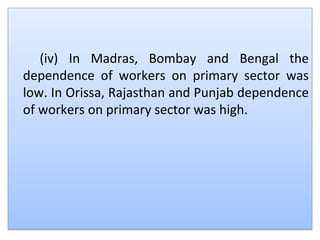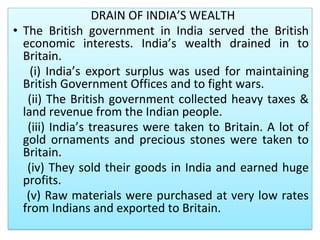India on eve on independence is the name
- 1. INDIAN ECONOMY ON TH EVE OF INDEPENDENCE CLASS – XII ECONOMICS Made by: KRISHNAKUMAR C S, DAV – BHEL SCHOOL, RANIPET, TAMILNADU Modified by: POONAM MEHRA
- 2. INDIAN ECONOMY BEFORE THE ESTABLISHMENT OF BRITISH RULE i. Agriculture was the main economic activity of the people. ii. Handicrafts industries like cotton textiles, silk textiles, metal and precious stone works were developed. iii. Indian handicrafts goods were World famous as they were of very good quality.
- 3. Agriculture was the main economic activity of the people.
- 4. Handicrafts industries like cotton textiles, silk textiles, metal and precious stone works developed.
- 5. MAIN PURPOSES OF BRITISH RULE IN INDIA SUPPLY RAW MATERIALS TO BRITISH INDUSTRIES PROVIDE MARKET FOR BRITISH GOODS
- 6. The British Government did not make efforts to estimate India’s GDP and Per capita GDP. • Some individuals like Dadabhai Naoroji, William Digby, Findlay Shirras, V.K.R.V. Rao and R.C. Desai made efforts to calculate India’s GDP. • V.K.R.V. Rao’s estimate is considered significant • During first half of 20th century India’s real output growth rate was less than 2% & growth rate of per capita income was less than 0.5% p.a.
- 7. Salient features of India’s agricultural sector during the colonial period Indian Agriculture was backward and stagnant during the British period. (i) Farming was completely dependent on rainfall. Irrigation facilities were not developed. So, crop failures were common. No investment was made in irrigation, flood control, etc. (ii) Before the arrival of British, agriculture was a subsistence activity (i.e. production for self-consumption). British rule led to commercialisation of agriculture (i.e. production for sale in market).
- 8. (iii) Most of the fertile land was owned by the Landlords. Most of the tillers were landless. (iv) Most of the farmers were poor. They did not have enough capital to invest in agriculture. Most of them were illiterate and ignorant. They did not know about the modern farming methods. (v) Before leaving, the British divided the country into 2. The fertile, jute producing land went to Pakistan (now Bangladesh), while jute producing factories came to India. These factories faced shortage of raw materials.
- 10. Causes of India’s agricultural stagnation during the colonial period? (i) Land was owned by the Zamindars. They collected heavy revenue from the farmers. The profits earned from agriculture went into the hands of the landlords and the British officials. Poor farmers had no incentive to increase farm output. (ii) The Government forced farmers to cultivate cash crops, like sugarcane, jute, cotton etc. The British paid very low prices for these crops. Some of these crops like indigo made land infertile. Farmers stopped cultivating food crops, resulting in their shortage & price rise.
- 11. (iii) Neither the Landlords nor the British government took any steps to provide irrigation facilities to farmers or modernize farming. (iv) Most of the farmers were poor and ignorant. They used primitive methods of cultivation. Agricultural productivity remained very low.
- 12. Commercialisation of Farming • Cultivation of crops for selling in the market is called commercial farming. • The British wanted raw materials for their industries. So, they encouraged the cultivation of cash crops like indigo, cotton, sugarcane etc. • The farmers were paid very low prices for their crops. • As they stopped the cultivation of food crops like wheat and rice, they had to buy food from the market. They did not have enough money. So, starvation started.
- 14. Main features of India’s industrial sector on the eve of Independence. • (i) The British had a TWO-FOLD motive of ‘de-industrialising’ India. Their aim was to convert India into a market for their finished goods and a source of raw materials to feed their industries. • (ii) The Indian traditional handicraft industry declined. The Indian goods lost their domestic and international demand.
- 15. • (iii) Growth of modern industries was very slow in India. The government did not take any step for industrial development. The role of public sector was limited to railways, power generation, Post & Telegraph and ports. • (iv) Very few industries existed in India during Colonial rule. These were sugar, cement, paper, cotton & jute textiles. TISCO (Tata Iron & Steel Company) was established in 1907. • (v) Capital goods industries did not come up in India. We had to import all machines and tools from Britain.
- 16. Factors Responsible for the decline of Indian handicrafts industries(Cottage and village industries) (i) Discriminatory Tariff Policy: The British Government imposed heavy duty on Indian exports to countries other than Britain & no duty on the raw materials sold to Britain. At the same time the government allowed duty free import of British foreign goods in to India. So, Indian handicrafts lost their domestic & international demand. (ii) Competition from British Goods: Low cost and better finished British goods were imported to India on a large scale. So, our goods faced stiff competition in the domestic market.
- 17. (iii) Shortage of raw materials: As most raw materials were exported to Britain, the Indian craftsmen faced shortage of raw materials & had to close down. (iv) Loss of Patronage: The royal class which supported the craftsmen & artisans, started losing battles to the British. This resulted in the loss of patronage to Indian handicrafts.
- 18. FOREIGN TRADE (i) The British established monopoly over India’s foreign trade due to the opening up of SUEZ CANAL. More than half of our trade was with Britain. Other trading partners were China, Srilanka (Ceylon) and Iran (Persia). (ii) Before the colonial period, India was a major exporter of finished goods. The British rule converted India into an exporter of primary products or raw materials(like raw silk, cotton, sugarcane, indigo, jute etc). and an importer of finished goods (like cotton, silk, jute clothes and machines).
- 19. INDIA’S BALANCE OF TRADE (or Drain of Wealth) • India’s balance of trade was favourable. There was export surplus. Several essential commodities were sold to Britain at low prices, resulting in their shortage in India. • The export surplus did not bring Pound (British currency), gold or silver to India. It did not benefit India because: (i) the surplus was used to maintain the office set up by the colonial Government. (ii) to meet the expenditure on wars fought with Indian rulers. (iii) to pay salaries & pensions to British officials working in India.
- 20. DEMOGRAPHIC PROFILE Demography is the study of population. First official population census was conducted in 1881. Population situation also showed backwardness. (i) Overall literacy rate was less than 16%. Female literacy rate was 7%. (ii) Death rate was very high due to inadequate public health facilities. Air & water borne diseases were common. (iii) Infant Mortality Rate was nearly 218 per thousand. (iv) Life expectancy at birth was very low (44 years)
- 21. THE YEAR OF GREAT DIVIDE 1921 is considered as the year of Great Divide. Before 1921, India was in the 1st stage of Demographic transition. The population growth rate was not very high. After 1921, theIndian population showed a continuous increase.
- 22. OCCUPATIONAL STRUCTURE Occupational structure refers to distribution of working population across primary, secondary and tertiary sectors of the economy. Occupational structure also showed backwardness. In all developed countries secondary and tertiary sectors provide more employment, while in India it was the primary sector. (i) 70 to 75% of Indian working population was engaged in primary sector. (ii) 10% of the workers were in the secondary sector. (iii) Tertiary sector employed nearly 15 to 20% of the workers.
- 23. (iv) In Madras, Bombay and Bengal the dependence of workers on primary sector was low. In Orissa, Rajasthan and Punjab dependence of workers on primary sector was high.
- 25. The British government developed the following infrastructural facilities in India: A) Transport: (i) Railway was introduced in India in 1850. Railway helped the English to transport their goods to the interior parts of India. It also helped in the quick movement of their armed forces. (ii)Seaports were developed to handle the export of raw materials to Britain and import of finished goods to India. (iii) The Inland waterways were built by spending huge amount of money. But these were uneconomical compared to Railways. (iv) A number of roads were constructed. Roads also helped them to transport their goods. B) Communication: Post and Telegraphs were developed. facilities were needed for the easy administration of India.
- 26. INTRODUCTION OF RAILWAYS Railways were introduced in 1850 in India. • POSITIVE EFFECTS OF RAILWAYS ON INDIA: • Railways helped people to travel long distances. Thus it promoted National Integration. • Railways promoted Commercial farming. • Volume of India’s export trade increased. • Large number of people got jobs in Railways.
- 27. NEGATIVE EFFECTS OF RAILWAYS ON INDIA: • Railways helped British to collect raw materials from interior parts of India and sell finished goods even in remote areas. This resulted in the decline of Indian Handicrafts industries. • Introduction of Railways promoted Commercial Farming. The villages lost their self sufficiency. • Railways helped British to move their army quickly and suppress National Movements.
- 29. POSITIVE CONTRIBUTIONS OF BRITISH RULE Following were the positive contributions made by the British in India (i) The British introduced commercial agriculture in India. This led to marketable surplus & rise in farmers income. (ii) Development of Roads and Railways contributed to the socio-economic progress of the country. (iii) Introduction of a common currency contributed to economic progress. (iv) The British introduced an efficient system of administration in India. (v) Introduction of modern anglicised education helped in the cultural and intellectual awakening of India.
- 30. DRAIN OF INDIA’S WEALTH • The British government in India served the British economic interests. India’s wealth drained in to Britain. (i) India’s export surplus was used for maintaining British Government Offices and to fight wars. (ii) The British government collected heavy taxes & land revenue from the Indian people. (iii) India’s treasures were taken to Britain. A lot of gold ornaments and precious stones were taken to Britain. (iv) They sold their goods in India and earned huge profits. (v) Raw materials were purchased at very low rates from Indians and exported to Britain.
- 31. ECONOMIC CHALLENGES ON THE EVE OF INDEPENDENCE (i) Indian agricultural sector was backward. Productivity was very low. Primitive methods of cultivation and the unjust land tenure systems were responsible for the backwardness of agriculture. (ii) Traditional Indian cottage industries declined due to the economic policies of the British government. The growth of modern industries was very slow. (iii) A large section of the population suffered from poverty. Starvation deaths were reported from many places.
- 32. (iv)India’s occupational structure was unbalanced. Major section of the workers was engaged in primary sector. (v) The British rule converted India from the position of a major exporter of finished goods to a major importer of finished goods. (vi) Our Balance of Trade was favourable, but didn’t result in any inflow of foreign exchange. Most of our trade was with Britain. (vii) Rail & road network had to be extended to the entire country.
- 33. THANK YOU
































